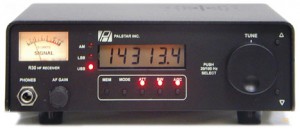By Steven Greenyer
I would usually be wary of purchasing a new communications receiver without having seen and tried one first, or at least speaking to someone in NZ that was using one. Overseas reviews aren’t always a reliable indicator of a receiver’s suitability for New Zealand listening conditions, especially as a predominately MW Dxer, our use of beverage antennas. Fortunately I was able to read a review by a respected North American Dxer who provided a reasonably detailed description from a MW Dxers perspective. This along with the price and specifications was enough to convince me to purchase one.
The radio was available direct from the manufacturers or from Universal Radio, while slightly more expensive from the manufacturers I chose this option as I felt it would be beneficial should I have any problems (a wise decision). An email and credit card resulted in a prompt delivery by registered post. I had explained that in a former life I was a radio technician and asked if they had noticed any common problems with the set that might provide a problem given my isolation from the US. They sent me a spare switched volume control as they had
experienced some problems with this control in the past. I don’t consider this an admission of weakness but very good customer relations.
The radio is not large about the size of a decent car stereo; if you are looking for bells and whistles then this is not the radio for you. It is a basic receiver, no fancy stuff, the front panel consists of an LCD display, headphone socket, on/off volume control, dual rate tuning knob, up down tuning buttons, and switches for, dual bandwidths (6 & 2.4kHz), attenuator, memory, AGC rate and SSB mode. On the rear are hi and low impedance antenna inputs, line out, extension speaker out, external power jack, a mute socket, LCD backlight switch and a switch to feed 12 volts down the antenna line to an active antenna. The top of the
cabinet holds a small speaker.
The radio has no inbuilt power supply, but does have an internal battery holder for AA batteries. While I haven’t tried these, their life would be reasonably short. I power mine from a 7 ampere hour sealed lead acid battery, which gives several nights listening. It could however be run from a quiet 12 volt transformer supply. Tuning can be by the knob at two rates 20 or 500Hz per revolution or using the up down buttons for 500 kHz steps. In memory mode the knob allows tuning through the 100 preset memories or you can use the up down buttons stepping through each memory, I find both methods useful. If you want all the technical details I suggest you go to one of the several web sites that have this available.
I have been able to try the radio on various beverages at Tiwai and Waianakarua and on shorter wires and active antennas. Having DXed for about 35 years I have tried many radios, in my opinion performance is very good and only marginally less than much more expensive receivers. For me it replaced a Sony ICF6800w, in my opinion a fine MW receiver only bettered in sensitivity on MW by the Drake SPR4. The Palstar is certainly as good on MW as the Sony and has some additional benefits, in memory size, sideband performance and audio quality.
Within the first week of use I had a major disaster, I hooked up my notch filter to the extension speaker socket, the crackling noise on the notch filter speaker should have been sufficient warning that all was not well, this was however confirmed by the burning smell and loss of audio from the radio. I had destroyed the audio output i.c. An email to Palstar confirmed that nothing but dollars would fix it, as I had probably cooked the regulator i.c. as well. A bit of testing by me confirmed that it was still ok, rather than go to the expense of returning the set to the States and the estimated $US75 repair bill, Palstar sent me a new i.c. free. I fitted this (not a job for an amateur) and the new volume control, as the audio i.c is d.c. controlled by this control it had damage it as well. The set has been back in service for over a year now, and I have had no previously identified problem with the volume control. Basically the cause was the fact that the speaker output is above ground i.e. one wire is not at earth or negative potential and the input to the notch filter is. I feel with the number of add on audio
processors, etc around Palstar should warn users about the potential for problems given the configuration of the speaker output. I have tried several emails to get Palstar to comment on this but with no luck. Strange, as they seem to have a reasonably good customer follow up.
My set also has a very, very intermittent fault in which the frequency reverts to 100 kHz, I have read about this happening but haven’t bothered pursuing a fix as it is not a common occurrence, switching the set off and on corrects it. Overall I am very pleased with the set, it could have more fancy functions but in my
experience most of these add very little to DX, if the signal is that hard to hear, then I’ll look elsewhere. Given our 9 kHz spacing on MW, a notch filter would be useful, but the set does have very good side band performance, tuning at 500Hz per turn is a little slow at times on sw. However I am more than happy with the set and would recommend it to serious MW Dxers or SW listeners.




